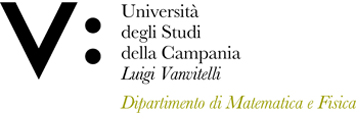Eugenio LIPPIELLO
Insegnamento di TERMODINAMICA E COMPLEMENTI DI MECCANICA
Corso di laurea in FISICA
SSD: FIS/01
CFU: 8,00
ORE PER UNITÀ DIDATTICA: 72,00
Periodo di Erogazione: Secondo Semestre
Italiano
| Lingua di insegnamento | ITALIANO |
| Contenuti | 1) Dinamica di sistemi di punti materiali |
| Testi di riferimento | - C. Mencuccini, V. Silvestrini, Fisica I – Meccanica Termodinamica, Liguori Editore |
| Obiettivi formativi | L'insegnamento si prefigge di fornire conoscenze di base |
| Prerequisiti | Cinematica e dinamica del punto materiale |
| Metodologie didattiche | ll corso è articolato in 52 ore di lezione frontali (di cui, 24 per la dinamica del punto materiale e del corpo rigido, 14 per la Termodinamica e 4 per le e Onde meccaniche) e 16 ore di esercitazioni e 4 ore di studio assistito, il tutto svolto in aula. |
| Metodi di valutazione | L' esame prevede una prova scritta ed una prova orale, entrambe obbligatorie, che contribuiscono al voto finale con un peso di 40% e 60% rispettivamente. |
| Altre informazioni | Le tracce delle prove scritte d’esame sono reperibili sul sito del Dipartimento (http://www.matfis.unicampania.it/dipartimento/docenti?MATRICOLA=057187), alla voce “Materiale Didattico” che conduce allo SharePoint dell’Ateneo). |
| Programma del corso | Sistemi di Punti materiali (5 CFU) |
English
| Teaching language | Italian |
| Contents | 1) Dynamics of Multiple Point Systems |
| Textbook and course materials | -- C. Mencuccini, V. Silvestrini, Fisica I – Meccanica Termodinamica, Liguori Editore |
| Course objectives | The course is aimed at providing basic knowledge about |
| Prerequisites | Material point kinematics and dynamics |
| Teaching methods | The course is structured in 52 hours of lectures (24 for the multiple point and rigid body dynamics, 14 for the Thermodynamics and 4 for mechanical waves) and 16 hours of exercises in the classroom and 4 hours of assisted study, . |
| Evaluation methods | The examination is structured in written test and an oral interview Both are mandatory and contribute with a weight of the 40% and 60% to the final vote, respectively. The written test takes place in the classroom and is based on the solution of simple problems of Mechanics and Thermodynamics. The use of pocket calculators is allowed whereas the use of tests ad didattic material is forbidden. The test must be evaluated at least 15/30 to access to the oral interview and the maximum evaluation is 30/30. |
| Other information | Examples of written tests can be found at (http://www.matfis.unicampania.it/dipartimento/docenti?MATRICOLA=057187). |
| Course Syllabus | Multiple Point Systems (5CFU): |








